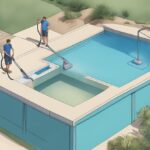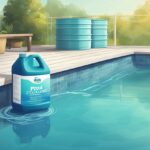Cyanuric acid is a crucial component that acts as a stabiliser for the chlorine in your pool. It’s commonly known as a chlorine stabiliser because it effectively binds with the chlorine and shields it from the degrading effects of the sun’s ultraviolet rays. Without it, chlorine, the primary sanitiser in your pool, would quickly break down, leaving your water unprotected against bacteria and algae.

Understanding the balance of chemicals in your pool is essential for maintaining a healthy swimming environment. Cyanuric acid plays a pivotal role in this balance by enabling the chlorine to last longer despite constant exposure to sunlight. Ensuring proper levels of cyanuric acid can effectively prolong the life of your pool’s chlorine, making it more cost-efficient and reducing the frequency of chemical top-ups required.
It’s worth noting, however, that while cyanuric acid helps protect chlorine and extend its sanitising effects, maintaining the correct balance is critical. Too little cyanuric acid won’t offer sufficient protection for your chlorine, while too much can reduce chlorine’s effectiveness. Keep this balance in mind to ensure your pool remains a safe and pleasant environment for everyone.
Understanding Cyanuric Acid
Cyanuric acid is essential for the longevity of chlorine in your pool, acting as a stabiliser against UV rays. It ensures your pool remains hygienic and safe for swimming.
Basic Chemistry of Cyanuric Acid
Cyanuric acid (CYA), also known as 1,3,5-triazine-2,4,6-triol or pool conditioner, is an organic compound with the formula (CNOH)_3. Its role is to protect chlorine molecules from being rapidly degraded by ultraviolet (UV) light from the sun. CYA is a weak acid and is typically sold as a white granular product or in liquid form.
The Role of Cyanuric Acid in Pool Maintenance
CYA is crucial in maintaining an effective sanitiser level in your pool. Without it, your chlorine would dissipate quickly under the sun’s UV rays, leaving your pool vulnerable to contaminants:
- Sanitizer Protection: Cyanuric acid binds to free chlorine, reducing its reactivity to sunlight. This pairing effectively extends chlorine’s lifespan in the water.
- Chlorine Stabilisation: Without CYA, you’d need to add chlorine more frequently. An ideal CYA level keeps chlorine in the water long enough to be effective against bacteria and algae.
Types of Cyanuric Acid Products
There are several types of cyanuric acid products available, each containing CYA to help keep your chlorine levels stable:
- Trichlor: Trichloroisocyanuric acid contains CYA and is a slow-releasing chlorine product.
- Dichlor: Dichloroisocyanurate, available as either sodium or potassium salts, dissolves quickly and also contains CYA.
- Chlorine Tablets: Often contain CYA along with chlorine to stabilise the tablet against UV degradation.
Understanding which CYA product suits your pool is vital for maintaining water quality and ensuring the effectiveness of your pool’s sanitising system.
Balancing Your Pool Chemistry
Achieving the right chemical balance in your pool is essential for maintaining clean and safe swimming conditions, particularly balancing cyanuric acid (CYA) levels to ensure the efficacy of chlorine.
Determining Cyanuric Acid Levels
You must regularly test the CYA levels in your pool to maintain water chemistry. An ideal range for cyanuric acid is between 30 and 50 parts per million (ppm). Use a reliable testing kit or test strips for accurate measurement. If you have a test kit, follow the instructions precisely for the most accurate results.
Effect on Chlorine Efficacy
Cyanuric acid acts as a stabiliser for chlorine, protecting it from the sun’s UV rays. The correct amount allows for optimum chlorine efficacy in killing bacteria and other contaminants. However, if the CYA level surpasses 50 ppm, it can overly stabilise chlorine, rendering it less effective. Strive to maintain a free chlorine level that’s 7.5% of the CYA level; for instance, if CYA is at 50 ppm, your free chlorine should be around 3.75 ppm to effectively sanitise your pool.
Adjusting Cyanuric Acid Concentration
To increase CYA levels, add cyanuric acid directly into your pool skimmer and run your pool pump to circulate the water. If your CYA levels are too high, you may need to partially drain and refill your pool or use a cyanuric acid reducer. Regular adjustments might be necessary to counterbalance factors that introduce or dilute CYA, such as rainfall or adding fresh water. Keep track of both total chlorine and combined chlorine levels, as well as other aspects of water chemistry such as pH and alkalinity, to ensure all components are within their ideal ranges.
Practical Application and Safety
When managing your pool’s chemistry, safely handling cyanuric acid is crucial, as it ensures a well-maintained swimming environment. Understanding routine maintenance and troubleshooting will empower you as a pool owner to keep your swimming pool in top shape.
Safe Handling and Storage of Cyanuric Acid
Cyanuric acid, essential for protecting free chlorine from sunlight, needs to be handled with care. Always wear safety goggles and acid-resistant gloves when handling this chemical. It’s recommended to add cyanuric acid to your pool by diluting it first. For instance, if you receive cyanuric acid in granular form, you should dilute it in a bucket of warm water before adding it to the pool.
- Storage: Store cyanuric acid in a cool, dry place away from children and pets. Make sure it’s in a container that’s clearly labelled and resistant to chemical damage.
- Handling: When adding cyanuric acid, ensure your pool’s pump is running to properly circulate the chemical throughout the pool. This will aid in the even distribution, providing effective sanitizing.
Routine Maintenance and Troubleshooting
Maintaining a balanced level of cyanuric acid is vital for the health of your pool, as it allows the chlorine to effectively sanitise the water, keeping harmful bacteria at bay. You should aim to maintain cyanuric acid levels between 30 and 50 parts per million (ppm) for outdoor pools. For indoor pools, cyanuric acid might not be necessary, as they are not exposed to sunlight.
- Maintenance: Regularly test and maintain your pool chemistry. If your cyanuric acid levels are consistently high, you might need to reduce them using cyanuric acid reducers, available at your local pool supply store.
- Troubleshooting: If you notice that your pool is becoming cloudy or algae is forming, it could be a sign that your cyanuric acid levels are off. After backwashing your filter, test the water. If needed, add cyanuric acid to bring the levels up, or use a reducer to bring them down.
Remember, always follow the manufacturer’s instructions when using cyanuric acid or reducers to ensure you’re achieving the proper balance in your pool. Proper maintenance of the pump and filter, along with routine water testing, will keep your swimming pool clean and safe for everyone.
Advanced Considerations for Pool Owners

Managing cyanuric acid (CYA) levels is crucial for keeping your pool water in perfect swimming condition. Neglecting this can lead to long-term consequences, and the type of pool you possess comes with different CYA considerations.
Long-Term Effects of Incorrect CYA Levels
Over time, incorrect levels of CYA in your pool can lead to several issues. If CYA levels are too high, chlorine becomes less effective, which could result in algae growth and contaminant build-up despite the appearance of adequate free chlorine. This high CYA level is often referred to as chlorine lock, where the chlorine’s efficacy is significantly impeded.
On the other hand, insufficient CYA causes chlorine to dissipate quickly under ultraviolet rays from sunlight, increasing your chlorine demand and the need for frequent chlorine shock treatments. This not only makes maintaining proper chlorine levels labour-intensive and costly but can result in an unpredictable swimming environment with spikes and dips in sanitizer levels.
To avoid these scenarios, regularly retest your pool water, ideally aiming for CYA levels to remain between 30 and 50 parts per million (ppm), ensuring optimal balance and protection for your pool’s sanitizer.
Cyanuric Acid in Different Pool Types
Each pool type presents distinct CYA management challenges.
- Outdoor pools typically require more CYA due to the contact with direct sunlight. CYA acts as a stabilizer, protecting chlorine from being broken down by UV rays.
- Indoor pools, shielded from sunlight, need less CYA since the chlorine is not as prone to degradation from UV exposure.
- Saltwater pools generate their own chlorine and also benefit from CYA to maintain the correct chlorine residual.
- Owners of pools with a vinyl liner or fiberglass should be cautious not to let CYA or calcium hardness levels get too high, which can lead to issues with the surfaces.
- Hot tubs, due to higher water temperatures, can have accelerated triazine build-up (a byproduct of CYA and chlorine), which necessitates more frequent water changes.
For specialised pool types like saltwater or vinyl-lined pools, adhering to manufacturer recommendations regarding CYA levels can prolong the life of the pool liner and ensure efficient performance of the filtration system.
In any scenario, integrating routine practices like using a 5-gallon bucket for dilution when adding chemicals, or knowing when to partially drain and add fresh warm water, will ensure that CYA levels remain optimal and your pool experience remains safe and enjoyable.











